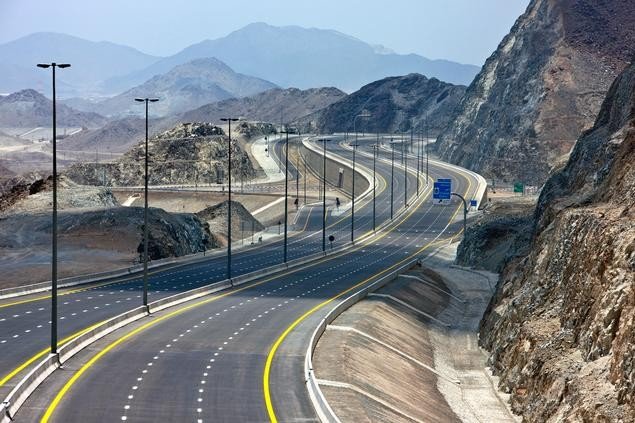Fujairah, one of the most beautiful and rapidly growing emirates in the UAE, is about to undergo a massive infrastructure upgrade that will dramatically improve its internal roads and overall city landscape. At the center of this ambitious plan is a 77-kilometer rainwater drainage network and the construction of two new tunnels. This large-scale project represents a crucial step toward enhancing road safety, reducing flooding risks, and boosting the city’s resilience against climate challenges.
This new development is a part of Fujairah’s ongoing efforts to modernize its infrastructure to meet the demands of its growing population and support economic and urban growth. Let’s take a closer look at what this project means for Fujairah, its residents, and visitors.
Why Fujairah needs a rainwater drainage network
Fujairah, known for its unique mountainous terrain and proximity to the sea, often experiences heavy rains during certain seasons. While the rain brings much-needed water to the region, it also causes significant challenges. One of the biggest issues has been flooding on roads, which disrupts traffic, damages vehicles, and poses serious risks to public safety.

Currently, many parts of Fujairah lack a comprehensive rainwater drainage system. Water tends to accumulate on roads and low-lying areas, creating hazardous conditions for drivers and pedestrians alike. In addition, stagnant water can damage road surfaces, lead to potholes, and affect nearby infrastructure.
By building a dedicated 77-kilometer rainwater drainage network, Fujairah aims to channel rainwater efficiently away from urban areas. This system will help keep the roads clear and safe during heavy rainfall, minimize waterlogging, and ensure smoother, uninterrupted traffic flow throughout the city.

Key highlights of the Fujairah rainwater drainage network project
The newly announced project is not just about building a drainage network. It also involves creating modern tunnels and upgrading the internal road system to improve connectivity and traffic management. Here are some key highlights of the project:
1. 77-kilometer rainwater drainage network
The star of this project is undoubtedly the extensive drainage network stretching 77 kilometers across the emirate. This network will collect rainwater from streets and residential areas and redirect it to safe disposal points or storage reservoirs.
The system is designed using advanced engineering techniques to handle large volumes of water quickly and efficiently. It will significantly reduce the risks of flooding, protect public and private properties, and improve overall urban resilience.
2. Construction of two new tunnels
Alongside the drainage network, the project includes the construction of two new tunnels. These tunnels will improve connectivity between different parts of the city, reduce traffic congestion, and provide alternative routes during emergencies or peak hours.
Tunnels are essential in mountainous regions like Fujairah. They offer a more direct and safer passage through hilly terrain, reducing travel times and minimizing environmental impact compared to open-cut roads.
3. Comprehensive road development
The project also involves upgrading and expanding internal roads to accommodate higher traffic volumes and future growth. Wider roads, better intersections, and safer pedestrian crossings will make driving and commuting in Fujairah more comfortable and efficient.

Benefits for residents and visitors
The Fujairah rainwater drainage network and road development project promise numerous benefits for both residents and visitors:
- Improved road safety: Flood-free roads mean fewer accidents and safer travel conditions, even during heavy rains.
- Reduced property damage: Efficient drainage will protect buildings and vehicles from water damage.
- Enhanced traffic flow: New tunnels and upgraded roads will ease congestion and shorten travel times.
- Support for tourism: Fujairah is a popular tourist destination, especially during weekends and holidays. Better roads and infrastructure will make the city more attractive and accessible.
- Boost to economy: Improved transport links facilitate smoother movement of goods and services, supporting local businesses and attracting investment.
Engineering challenges and solutions
Building a 77-kilometer rainwater drainage network and tunnels in a region with complex geography is no small feat. Fujairah’s landscape consists of mountains, valleys, and coastal plains, all of which pose unique engineering challenges.
Some of the main challenges include:
- Managing the flow of water from high elevations: During rainstorms, water rapidly flows down mountain slopes, causing sudden flooding. The drainage network needs to capture this flow early and redirect it safely.
- Designing tunnels in rocky terrain: Excavating tunnels through mountainous areas requires advanced engineering techniques to ensure stability and safety.
- Minimizing environmental impact: Construction must avoid damaging natural habitats and preserve Fujairah’s scenic beauty.
To overcome these challenges, engineers are using advanced modeling tools and sustainable construction practices. The drainage system, for instance, will include sedimentation basins and filters to prevent pollutants from entering the sea or underground water sources.
Environmental considerations
Sustainability is a key priority for the Fujairah rainwater drainage network project. The government is committed to ensuring that the new infrastructure aligns with the emirate’s environmental goals and long-term vision.
Some of the environmental measures include:
- Rainwater harvesting: Instead of simply disposing of rainwater, parts of the drainage network will direct water into storage reservoirs. This water can be used for irrigation or other non-potable purposes, reducing demand on freshwater supplies.
- Protecting marine life: Special care is being taken to prevent untreated runoff from reaching the ocean, helping to protect Fujairah’s rich marine ecosystems.
- Green construction practices: Contractors are required to follow strict guidelines to minimize dust, noise, and emissions during construction.
Economic impact of the project
Large infrastructure projects like this one do more than just improve roads. They stimulate the local economy in several ways:
- Job creation: The construction phase will create jobs for engineers, laborers, and support staff. Local businesses supplying materials and services will also benefit.
- Boost to local businesses: Better roads mean easier access to shops, restaurants, and tourism attractions, which helps small and medium enterprises thrive.
- Attracting investment: Investors are more likely to consider a city with reliable infrastructure. This project positions Fujairah as a forward-thinking emirate ready for future growth.
Community feedback and engagement
The government has been proactive in involving the local community in this project. Public meetings and consultation sessions have been held to explain the benefits, listen to concerns, and incorporate feedback into planning.
Residents have generally welcomed the project, expressing relief that the longstanding flooding issues will finally be addressed. Many people see it as a sign that Fujairah is investing in the well-being of its citizens and preparing for a sustainable future.

What’s next?
The project is already underway, with surveys, designs, and initial groundwork taking place across the city. The construction of the 77-kilometer rainwater drainage network and two tunnels is expected to progress in phases to minimize disruptions.
Key milestones in the coming months include:
- Completion of detailed designs for tunnels and major drainage segments.
- Beginning excavation work for the tunnels.
- Rolling out upgrades to internal roads, starting with high-priority areas.
- Gradual integration of rainwater harvesting and storage facilities.
The entire project is scheduled to be completed within a few years, transforming Fujairah’s infrastructure landscape.
Fujairah’s vision for the future
The Fujairah rainwater drainage network project is more than just an engineering effort — it’s a reflection of the emirate’s broader vision for the future. As one of the UAE’s emerging hubs for tourism, business, and culture, Fujairah is positioning itself as a modern, resilient, and attractive destination.
By investing in critical infrastructure today, Fujairah is ensuring that it can support a higher quality of life for its residents and continue to welcome visitors from around the world. Better roads, improved drainage, and modern tunnels will help the emirate cope with natural challenges and encourage sustainable growth.
Conclusion
The announcement of Fujairah’s 77-kilometer rainwater drainage network and two new tunnels marks a major milestone in the emirate’s development journey. This visionary project addresses the long-standing issue of flooding, enhances road safety, improves traffic flow, and supports economic growth.
Residents, businesses, and tourists all stand to benefit from this investment. As construction progresses, Fujairah is not only solving today’s problems but also building the foundation for a brighter, more sustainable future.
With this ambitious plan, Fujairah is setting an inspiring example for other cities facing similar challenges — showing that with vision, planning, and commitment, even the most complex problems can be turned into opportunities for growth and progress.
Do follow UAE Stories on Instagram
Read More: Wizz Air exit Abu Dhabi: Final flights, refunds & future plans














